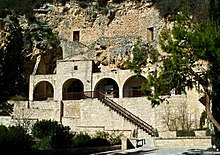The Agios Neophytos Monastery was founded by Neophytos. After being jailed for pursuing an ascetic life, he fled into the hills of Cyprus and found a small natural cave in 1159. Months passed while he made sure the area was deserted and quiet. He slowly excavated the opening further to encompass his hermitage cell, a small chapel, and his eventual tomb. While it began as a hermitage for Neophytos alone, he eventually gained a small following and the Engleistra, as it was also called, became a quiet monastic community in 1170 when the Bishop of Paphos convinced him to take a pupil. Neophytos was staunchly against materialism and being bothered, which kept the population of monks much smaller than at other monasteries of the time. In his second Ritual Ordinance, he states that the number of monks was around fifteen or eighteen.
After, his death, he was buried within the Engleistra according to his own detailed instructions. His successor, Isaias, is mentioned in the writings of Neophytos, but nothing is known about his time as abbot, nor is there any information about any other abbots during the 13th, 14th, or 15th centuries. However, it is speculated that the heads of the monastery following Neophytos did not hold to his isolationist lifestyle. The monastery was expanded and new paintings and decorations were added over the centuries, although not very often. One major overhaul was undertaken by another monk named Neophytos in 1503, who ordered the renovation of several original artworks as well as additional new icons, all paid for with his own money. The community fluctuated between growth and decline for several centuries, but became stagnant around the seventeenth century. In 1631, after the abbot Leontios set about to preclude its dissolution, it was declared to have precedence over all other monasteries on Cyprus by the Patriarch Cyril Loukaris from Constantinople. Over the last several centuries, the monastery and its buildings were often repaired and expanded upon to keep them from being lost to time. It continues to be inhabited to this day and the monks within promote the publication of historical manuscripts written within their walls in order to preserve their history. Hallows of Neophytos were found in 1756 and then were placed in the main church of the monastery.


.jpg)
No comments:
Post a Comment
Note: only a member of this blog may post a comment.